Thomas White is farming in Rapla, Rathdowney, Portlaoise, Co Laois. He runs a mixed farming enterprise comprised of dairy, beef and tillage.
For his entire farming career, Thomas has been milking the cows through a six-unit parlour that was built in the early 80s.
The parlour worked well when numbers were smaller.
However, over the past few years cow numbers on the farm have been on the increase with the abolition of milk quotas.
The larger numbers were putting pressure on the old parlour and the time it was taking to milk was taking its toll on Thomas.
“I was spending three hours in the parlour for each milking to get through 21 rows and I was constantly looking at the clock,” Thomas explained.
He said it had come to the point that new facilities were needed and so he decided to set about making it happen.
Figure one and picture one
Thomas had a good idea what he needed – a new cubicle shed to house the cows comfortably over the winter months and a larger parlour to make milking more efficient. He contacted Aidan Kelly from Agri Design and Planning Services in early 2018.
He supplied Thomas with some options and, after visiting another farm with a design Thomas liked, the plans were finalised. He decided to build a 144-cow cubicle shed with underground slurry storage.
A 16-unit parlour was positioned beside this shed with a handling area at the exit race.
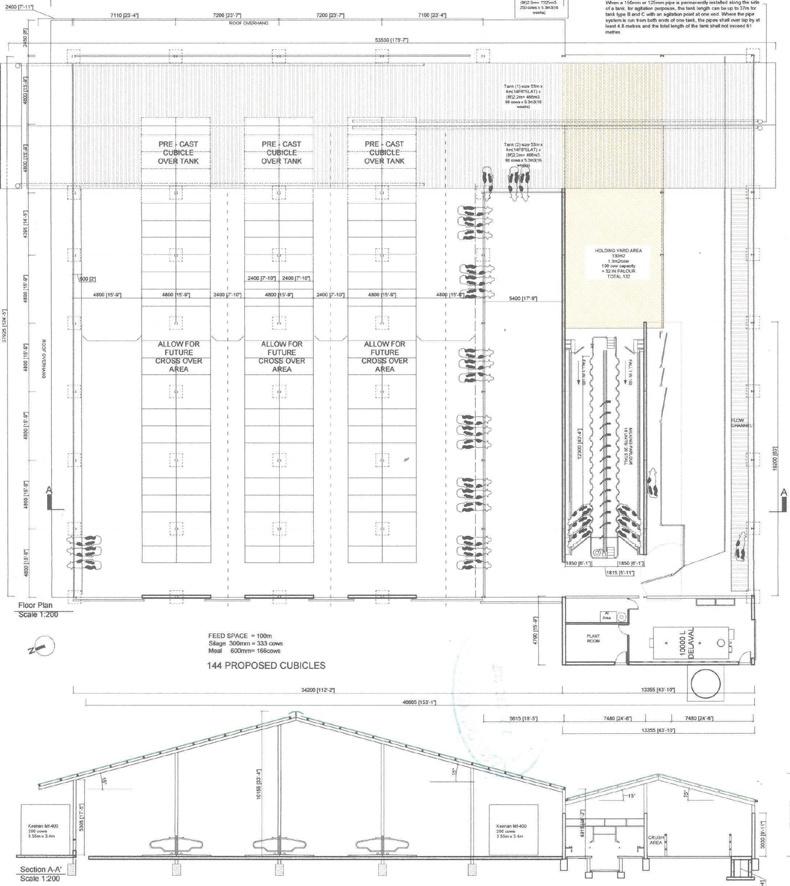
Figure one.
When planning permission was granted, work on the site started in January 2019. Spencer Plant Hire did all the excavating work.
This was quite a big job because the twin slurry tanks were large at 53m (173ft) long by 4m (14ft 6in) wide and 2.2m (8ft) deep. This equates to a total of 932m3 slurry capacity, enough to accommodate 176 cows for 16 weeks.
The side-by-side tanks are on one side of the shed and cater for both the cubicle shed and the collecting yard at the dairy parlour.
There is a slatted flow channel running the length of the exit race and it is connected to the main slurry tank. This is a very clever design as Thomas is getting more bang for buck out of his slurry tanks.
During the dry period in winter the slurry produced in the cow passages in the cubicle shed will be scraped to the slurry tank.
For most of the year any slurry produced by cows queuing for the parlour or exiting the parlour will also be collected in these tanks. The concrete and stone was supplied by Dowlings Quarries and the tanks were topped off with Banagher dairy cow slats.
Picture two and three
Thomas went with a 16-unit DeLaval herringbone parlour with room for four more units. Extras in this parlour included automatic cluster removers, a dump line and milk meters.
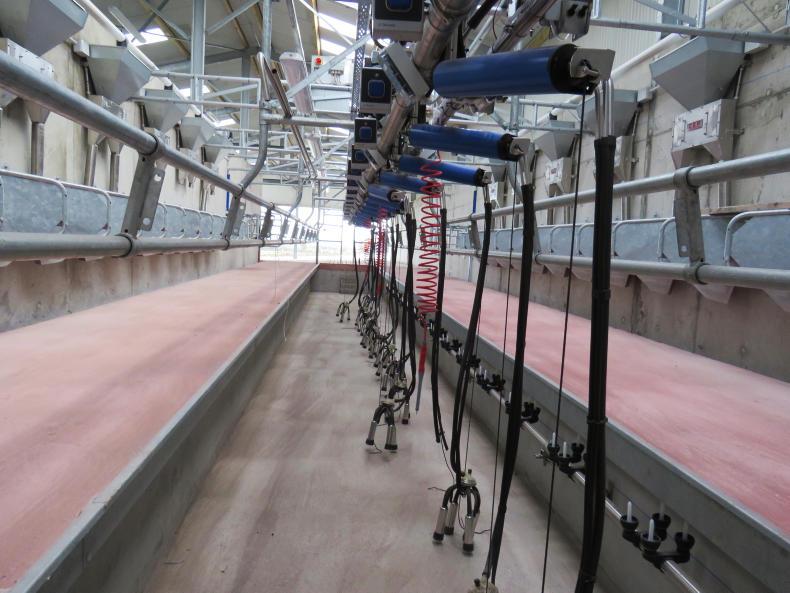
Picture two.
There are individual mangers to hold feed augured from the 16t Spirofeed feed bin. The automated feeding and the 10 extra units will speed up milking time dramatically on the farm.
There is an automatic washing system in the parlour which will start at the push of a button, saving Thomas more time. The parlour was fitted by EC Pratt & Co LTD based in Abbeylix and Gerry Fogarty carried out the electrical work.

Picture three.
A 12,000l Fullwood Packo bulk tank was installed in a room in the dairy. A plate cooler cools down the milk in the milk line with the aid of well water on the farm before milk enters this bulk tank.
This helps to reduce refrigeration costs. Outside at the front of the dairy timber cladding was erected and varnished to leave a nice tidy finish. All the carpentry work was carried out by Michael Ryan from Kilkenny.
Picture four
When cows exit the parlour they will usually leave via the slatted exit race. In this area there are some holding pens and a cattle crush.
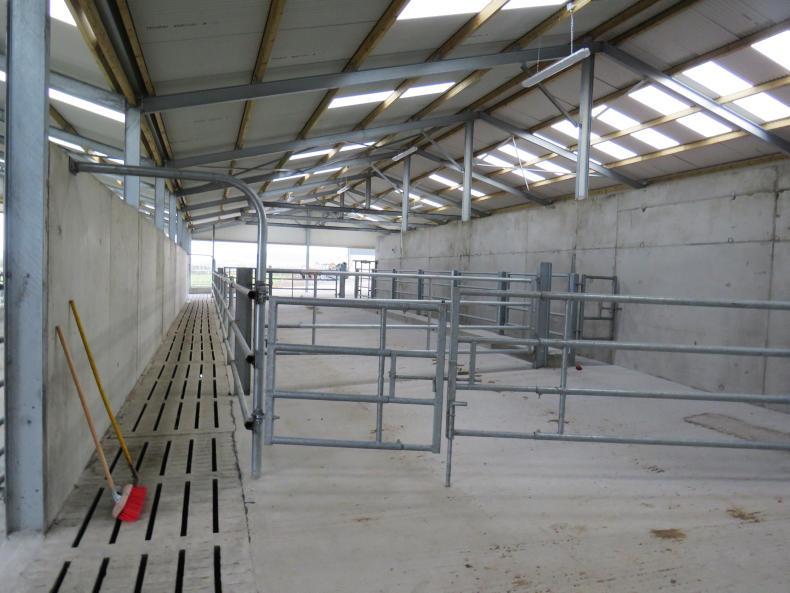
Picture four.
This will be used for AI, the TB test and animal health treatments. In the future Thomas plans on adding an automatic drafting gate to make drafting out cows easier.
Picture five and six
The cubicle shed is very impressive and really rounds off the whole development. Each cubicle is fitted with an Easyfix mattress which will no doubt ensure cow comfort over the winter months.

Picture five.
There are four ratchet scrapers fitted by Dairypower. Cows can feed on three sides of this shed, ensuring plenty of feed space for each animal.
There is a roof overhang which will help to keep silage dry and with the cubicle shed 4.9m (16ft) high at the eaves there will be no problem feeding with the large silage wagon.
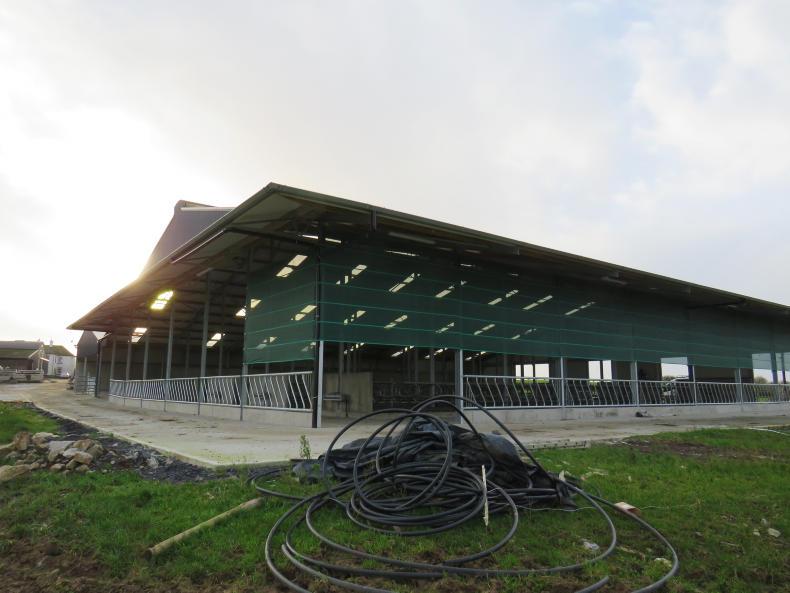
Picture six.
Oldtown Construction LTD erected the shed and did all the concrete work. During construction on a wet and windy day Thomas noticed that some of the cubicle beds were getting wet.
He decided to erect a Gailbreaker at one end of the shed to prevent this from happening in the future. It was erected by Peter Treacy and co.
As mentioned at the start of the article, work on the shed started in early January 2019 and it is now complete.
“We gave it the year to do because we didn’t want to rush things,” said Thomas. He said the whole development was costly but he is still very happy that he went ahead with the build.
“There is never a good time to make an investment like this and sometimes you just have to go and do it,” he said.
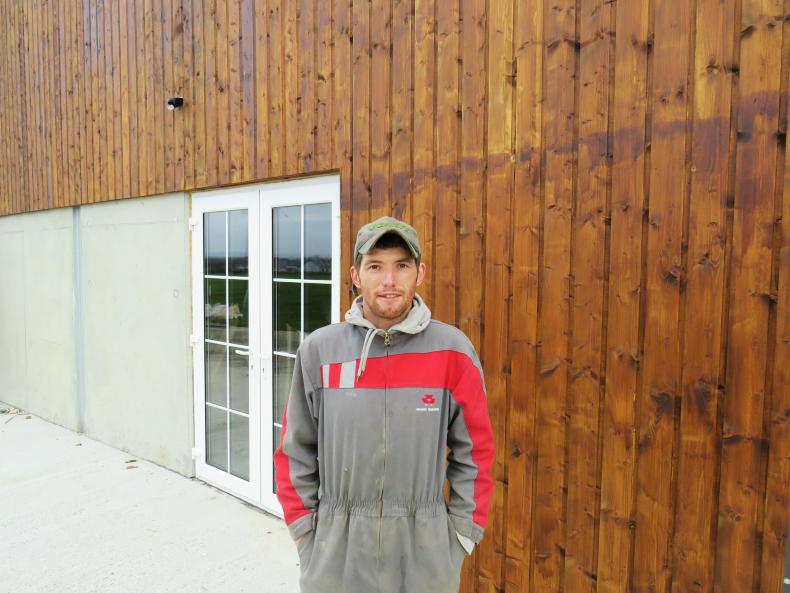
Thomas White is farming in Rapla, Rathdowney, Portlaois, Co Laois.
He is very thankful for the help given by his sister and brother in-law Mairead and Ian Cleary who were a great support during the build. In terms of cost the sheds, tanks, slats and cubicles cost €550,000 including VAT.
The milking parlour and equipment including the bulk tank and meal bin cost €150,000 including VAT. Wiring, cow mats and scrapers cost €65,000 including VAT.
Thomas was exceptionally happy with the quality of the work carried out by Oldtown Construction and is delighted how the cubicle shed and parlour turned out.
Thomas White is farming in Rapla, Rathdowney, Portlaoise, Co Laois. He runs a mixed farming enterprise comprised of dairy, beef and tillage.
For his entire farming career, Thomas has been milking the cows through a six-unit parlour that was built in the early 80s.
The parlour worked well when numbers were smaller.
However, over the past few years cow numbers on the farm have been on the increase with the abolition of milk quotas.
The larger numbers were putting pressure on the old parlour and the time it was taking to milk was taking its toll on Thomas.
“I was spending three hours in the parlour for each milking to get through 21 rows and I was constantly looking at the clock,” Thomas explained.
He said it had come to the point that new facilities were needed and so he decided to set about making it happen.
Figure one and picture one
Thomas had a good idea what he needed – a new cubicle shed to house the cows comfortably over the winter months and a larger parlour to make milking more efficient. He contacted Aidan Kelly from Agri Design and Planning Services in early 2018.
He supplied Thomas with some options and, after visiting another farm with a design Thomas liked, the plans were finalised. He decided to build a 144-cow cubicle shed with underground slurry storage.
A 16-unit parlour was positioned beside this shed with a handling area at the exit race.

Figure one.
When planning permission was granted, work on the site started in January 2019. Spencer Plant Hire did all the excavating work.
This was quite a big job because the twin slurry tanks were large at 53m (173ft) long by 4m (14ft 6in) wide and 2.2m (8ft) deep. This equates to a total of 932m3 slurry capacity, enough to accommodate 176 cows for 16 weeks.
The side-by-side tanks are on one side of the shed and cater for both the cubicle shed and the collecting yard at the dairy parlour.
There is a slatted flow channel running the length of the exit race and it is connected to the main slurry tank. This is a very clever design as Thomas is getting more bang for buck out of his slurry tanks.
During the dry period in winter the slurry produced in the cow passages in the cubicle shed will be scraped to the slurry tank.
For most of the year any slurry produced by cows queuing for the parlour or exiting the parlour will also be collected in these tanks. The concrete and stone was supplied by Dowlings Quarries and the tanks were topped off with Banagher dairy cow slats.
Picture two and three
Thomas went with a 16-unit DeLaval herringbone parlour with room for four more units. Extras in this parlour included automatic cluster removers, a dump line and milk meters.

Picture two.
There are individual mangers to hold feed augured from the 16t Spirofeed feed bin. The automated feeding and the 10 extra units will speed up milking time dramatically on the farm.
There is an automatic washing system in the parlour which will start at the push of a button, saving Thomas more time. The parlour was fitted by EC Pratt & Co LTD based in Abbeylix and Gerry Fogarty carried out the electrical work.

Picture three.
A 12,000l Fullwood Packo bulk tank was installed in a room in the dairy. A plate cooler cools down the milk in the milk line with the aid of well water on the farm before milk enters this bulk tank.
This helps to reduce refrigeration costs. Outside at the front of the dairy timber cladding was erected and varnished to leave a nice tidy finish. All the carpentry work was carried out by Michael Ryan from Kilkenny.
Picture four
When cows exit the parlour they will usually leave via the slatted exit race. In this area there are some holding pens and a cattle crush.

Picture four.
This will be used for AI, the TB test and animal health treatments. In the future Thomas plans on adding an automatic drafting gate to make drafting out cows easier.
Picture five and six
The cubicle shed is very impressive and really rounds off the whole development. Each cubicle is fitted with an Easyfix mattress which will no doubt ensure cow comfort over the winter months.

Picture five.
There are four ratchet scrapers fitted by Dairypower. Cows can feed on three sides of this shed, ensuring plenty of feed space for each animal.
There is a roof overhang which will help to keep silage dry and with the cubicle shed 4.9m (16ft) high at the eaves there will be no problem feeding with the large silage wagon.

Picture six.
Oldtown Construction LTD erected the shed and did all the concrete work. During construction on a wet and windy day Thomas noticed that some of the cubicle beds were getting wet.
He decided to erect a Gailbreaker at one end of the shed to prevent this from happening in the future. It was erected by Peter Treacy and co.
As mentioned at the start of the article, work on the shed started in early January 2019 and it is now complete.
“We gave it the year to do because we didn’t want to rush things,” said Thomas. He said the whole development was costly but he is still very happy that he went ahead with the build.
“There is never a good time to make an investment like this and sometimes you just have to go and do it,” he said.

Thomas White is farming in Rapla, Rathdowney, Portlaois, Co Laois.
He is very thankful for the help given by his sister and brother in-law Mairead and Ian Cleary who were a great support during the build. In terms of cost the sheds, tanks, slats and cubicles cost €550,000 including VAT.
The milking parlour and equipment including the bulk tank and meal bin cost €150,000 including VAT. Wiring, cow mats and scrapers cost €65,000 including VAT.
Thomas was exceptionally happy with the quality of the work carried out by Oldtown Construction and is delighted how the cubicle shed and parlour turned out.













 This is a subscriber-only article
This is a subscriber-only article










SHARING OPTIONS: